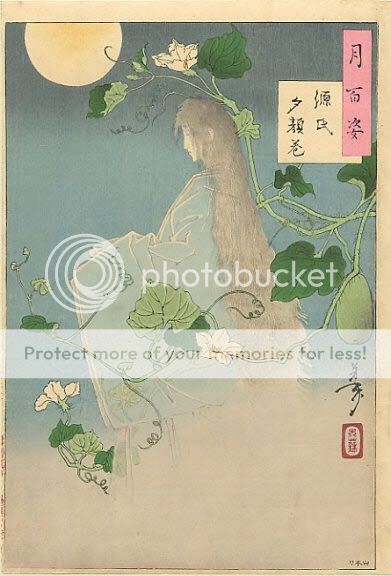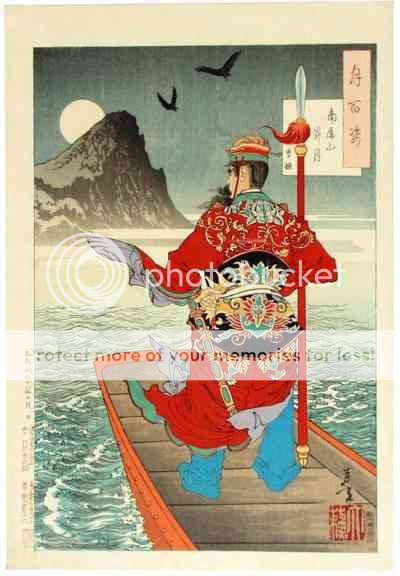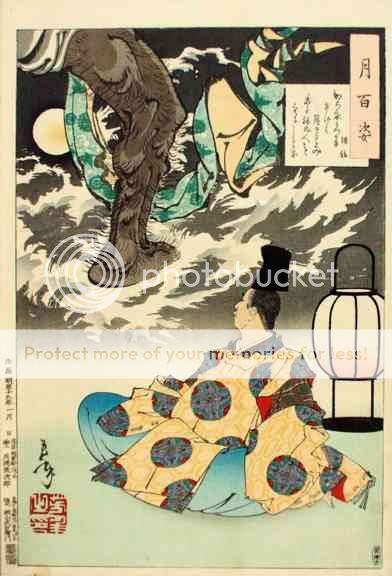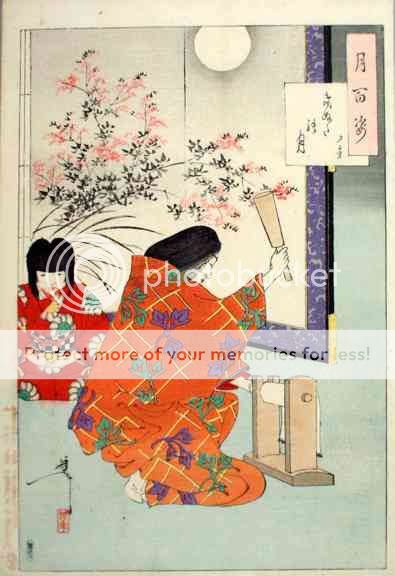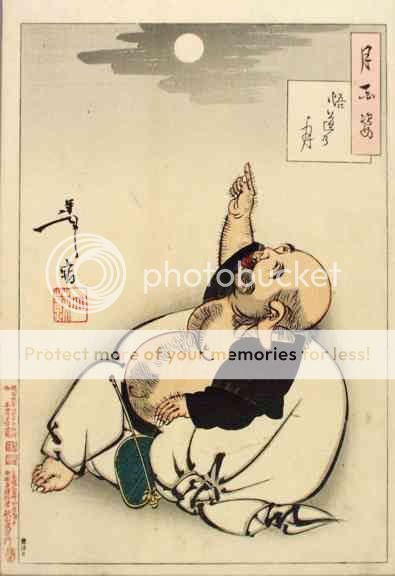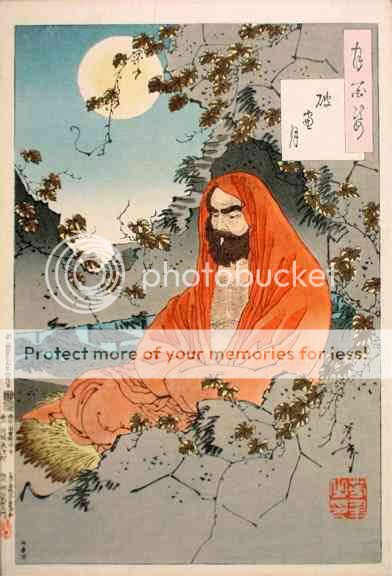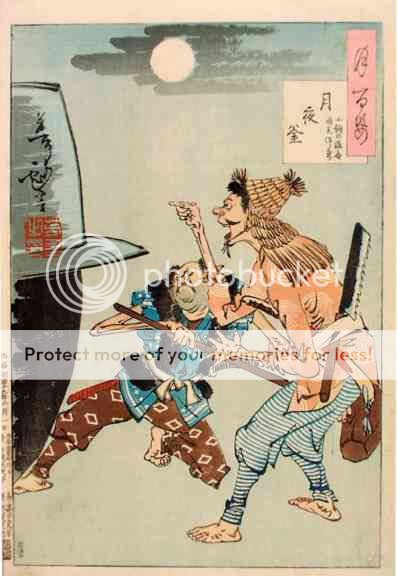I recently bought a book collecting all the prints from One Hundred Aspects of the Moon, a series from the late 1800s by Yoshitoshi, the last great classic ukiyo-e artist.
It’s a fascinating series for lots of reasons. I mentioned in my discussion of Kuniyoshi a while back how the Japanese print series prefigure manga, and the enthusiasm for manga in Japan, in a lot of ways. The most obvious way is that some of the images could actually be manga; the influence is so clear it’s a little uncanny. For example:
Those delicate tendrils, and the clarity against the ghostly figure, the precious crystalline, overwrought emotionalism — this couldn’t scream “shojo!” any more clearly. (The commentary on this site says that this design was known in Europe and influenced art nouveau as well, which is certainly believable.)
Beyond the clear visual influence, though, there’s also a kind of overarching formal influence. When talking about Kuniyoshi, I pointed out that the artist clearly thought about each series as a series — there wasn’t a sequential narrative, as in comics, but the work was unified by moods and themes in a way analogous to (if not mapping exactly onto) the way that comics unify image and text. You see something similar here as well. Obviously, the moon itself is a unifying visual motif, appearing as it does in almost every print (sometimes moonlight is just referred to in the text.) But even beyond that, there are a number of rhyming themes and scenarios which recur through the series. For example:
This is an image of a great Chines general Cao Cao, crossing the Yangtze river on the day before his defeat.
And this is the same place, eight centuries later, Su Shi, a poet, composes a verse by moonlight about, or inspired by, Cao Cao.
The two images aren’t contiguous in the series…they were made four years apart, apparently. But you have to think that Yoshitoshi remembered the first while he made the second, and that they’re meant to nod to each other, at least. Certainly, they complicate or expand on each other; in the first Cao Cao, in full glorious color, sails towards a tragedy he doesn’t know. But the poet (in a much less elaborate, less brighter image) does know it; the boat in fact almost seems to be sailing back, returning in the opposite direction to Cao Cao’s voyage. You can almost see the Cao Cao and the poet looking at each other, one not seeing (turned away), one seeing…but both transient compared to the ever-cycling, singular moon (and it is singular, since the moon in the first print actually seems to provide the moonlight for both images.)
I like this juxtaposition as well:
In the first, a courtier watches the moon rise when he hears the sound of cloth being pounded. He recites a verse about the sound…and then a demon appears to recite an answering verse. In the second, (again composed a number of years later), a wife whose husband has been away for years pounds cloth all night in the hope that her husband may hear her and come home. As in the first pair, you can imagine this as a kind of call and response; perhaps the courtier heard the woman’s pounding…or the demon did. The sense of reaching out and not knowing what will answer, of people separated by distance, who can perceive each other but not communicate, and the evocation of the uncanny in both images — it all ties in fairly clearly to the moon itself, shining in the distance, remote and unattainable, but nevertheless present (and again, one moon seems to suffice for both images, as if it’s light is illuminating both images.)
Or there’s this:
That image is called “Moon of Enlightenment” and it shows Hotei, who is drawn here (at least partly) in a quick, inky gestural style typical of zen calligraphy and illustration. According to my collection (edited by Tamara Tjardes, incidentally) He’s pointing to the moon, indicating the Zen teaching that the finger that points at the moon is not the moon, and so the search for enlightenment is not enlightenment itself.
The drawing itself is pretty spectacular (how can you *not* look at that beautifully drawn hairy arm and finger?). But Yoshitoshi also uses it (it seems to me) as a kind of gravitational center around which other images collect and revolve. For instance, this one (done earlier than the one above) is called, “The Moon Through a Crumbling Window.”
It shows Bodhidharma, the founder of Zen, meditating for nine years in his quest for enlightenment while the moon shines down on him. Contrasted with the drawing of Hotei above, it’s hard not to see a kind of ironic comment here — what are you meditating for! The moon (enlightenment) is right behind you, dope! And, of course, that kind of joke/insight/pratfall couldn’t be much more zen (or so Alan Watts told me, anyway.)
This is a nice rhyme too. It’s called “An Iron Cauldron and the Moon At Night.”
Like the Hotei drawing, this one is done in a more cartoony, comical style. The illustration is supposedly showing two crooks who try to steal a giant iron pot, but don’t realize that the full moon shows their efforts all too clearly. The finger pointing very much recalls Hotei…though, of course, it’s pointing to the wrong place; at the pot, not the moon. You won’t find enlightenment there…except zen might argue you sort of would. Certainly, there’s a parallel between the crooks who don’t notice the moon and the Bodhidharma in the previous picture who doesn’t notice the moon…and also between Hotei who points and the fool who points. Sages and criminal blunderers are more alike than not to the moon.
There’s at least one other finger pointing in the series…but I’ll let you find it for yourself if you’re so inclined. I wonder if that sort of game — searching for thematic rhymes, or just for repeated images — was part of what made a series like this so popular: people would apparently line up the night before a print was released to get a copy, like fans at a Twilight opening.
In any case, you look at this series and you can see why American and Japanese comics are so different. Narrative in this series isn’t important at all; it’s held together with a different glue. And that’s the case with a lot of manga as well, as far as I can tell. Not that they don’t have narrative, but they don’t tend to insist on it in the same way; they don’t really care if you follow the story exactly. Images and symbols and emotions are more important, or more trusted. Three or four generations ago, folks in Japan were accustomed to sleeping out in the cold all night to pick up the latest in a series that didn’t even both to tell a sequential story. Around the same time, folks in the U.S. were reading stuff like this:
No wonder we love our text boxes.

